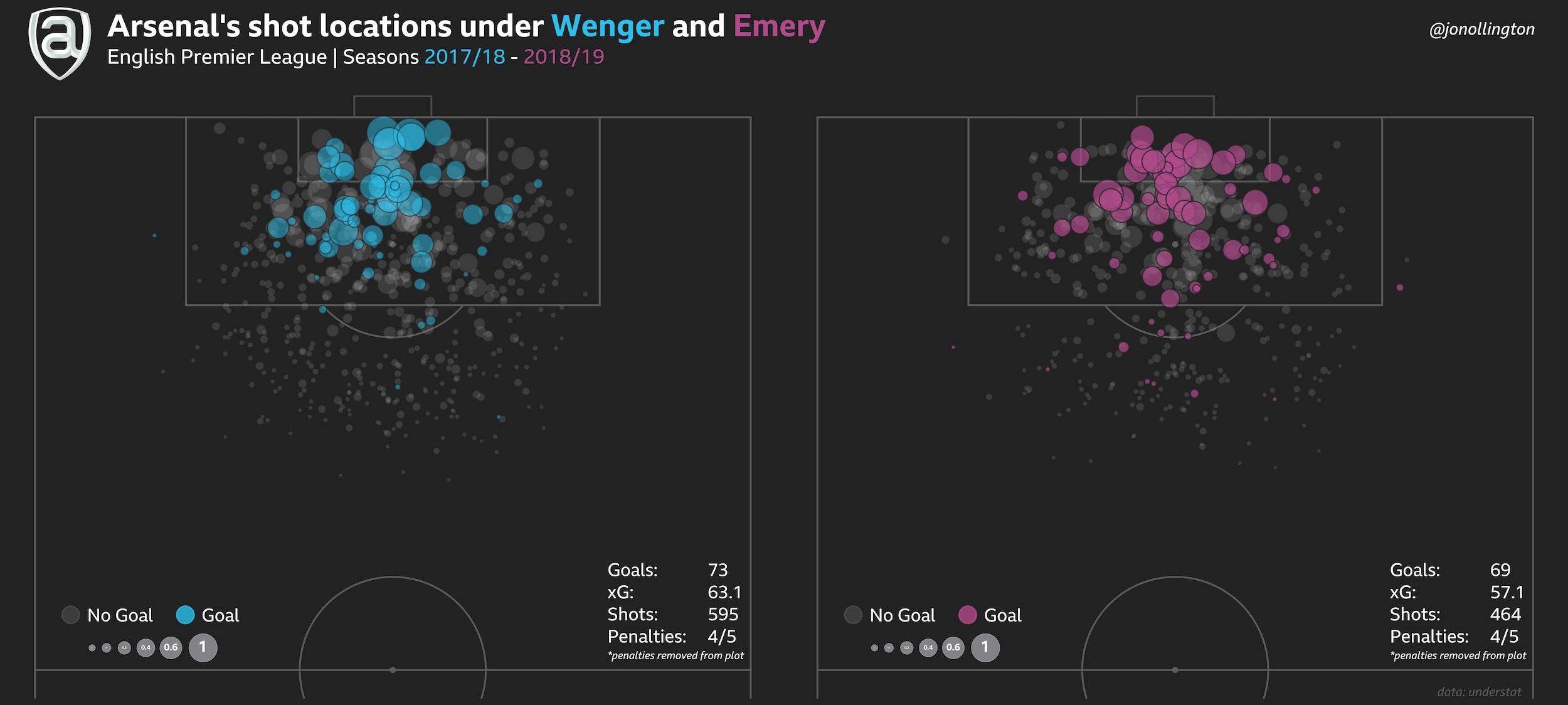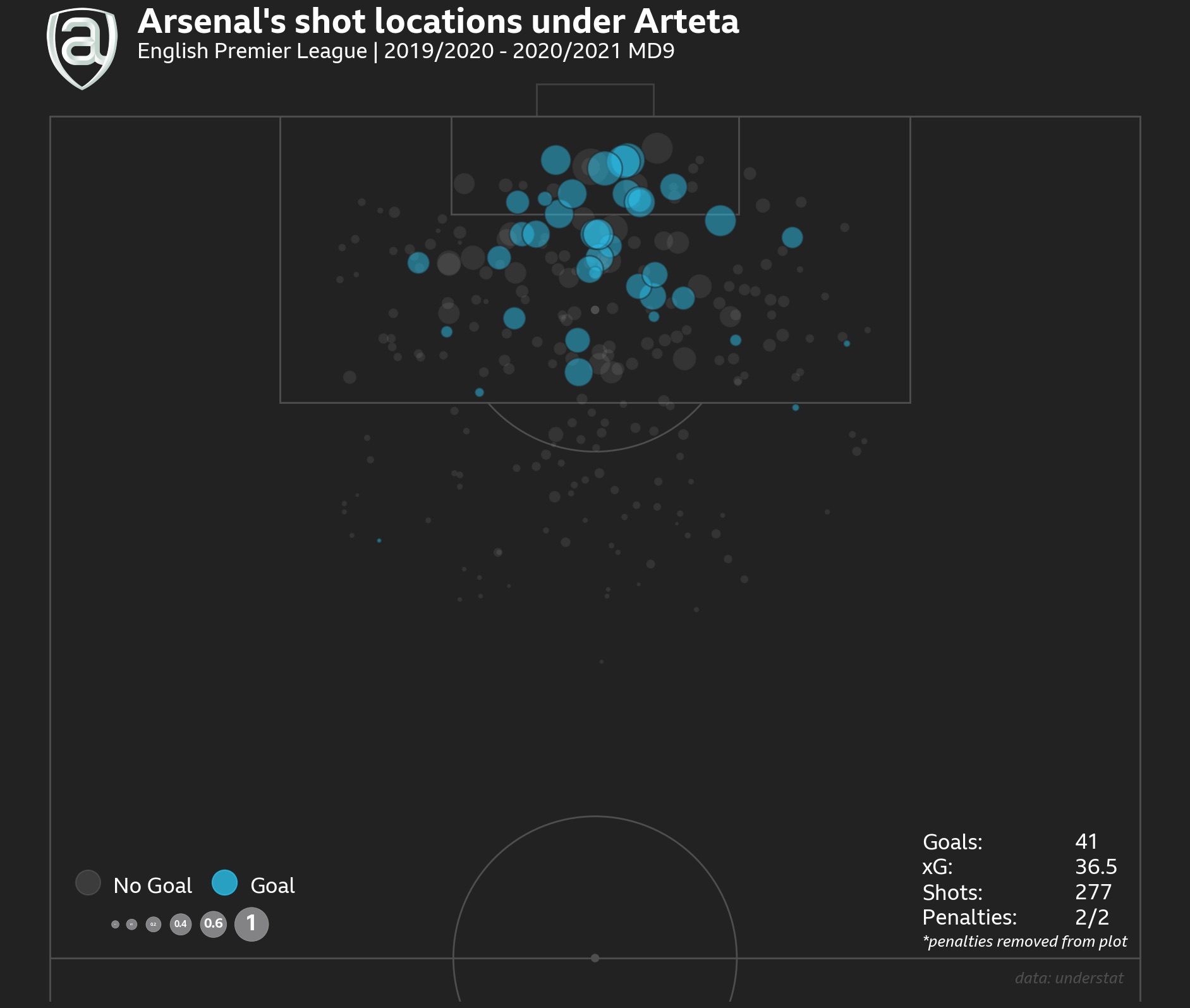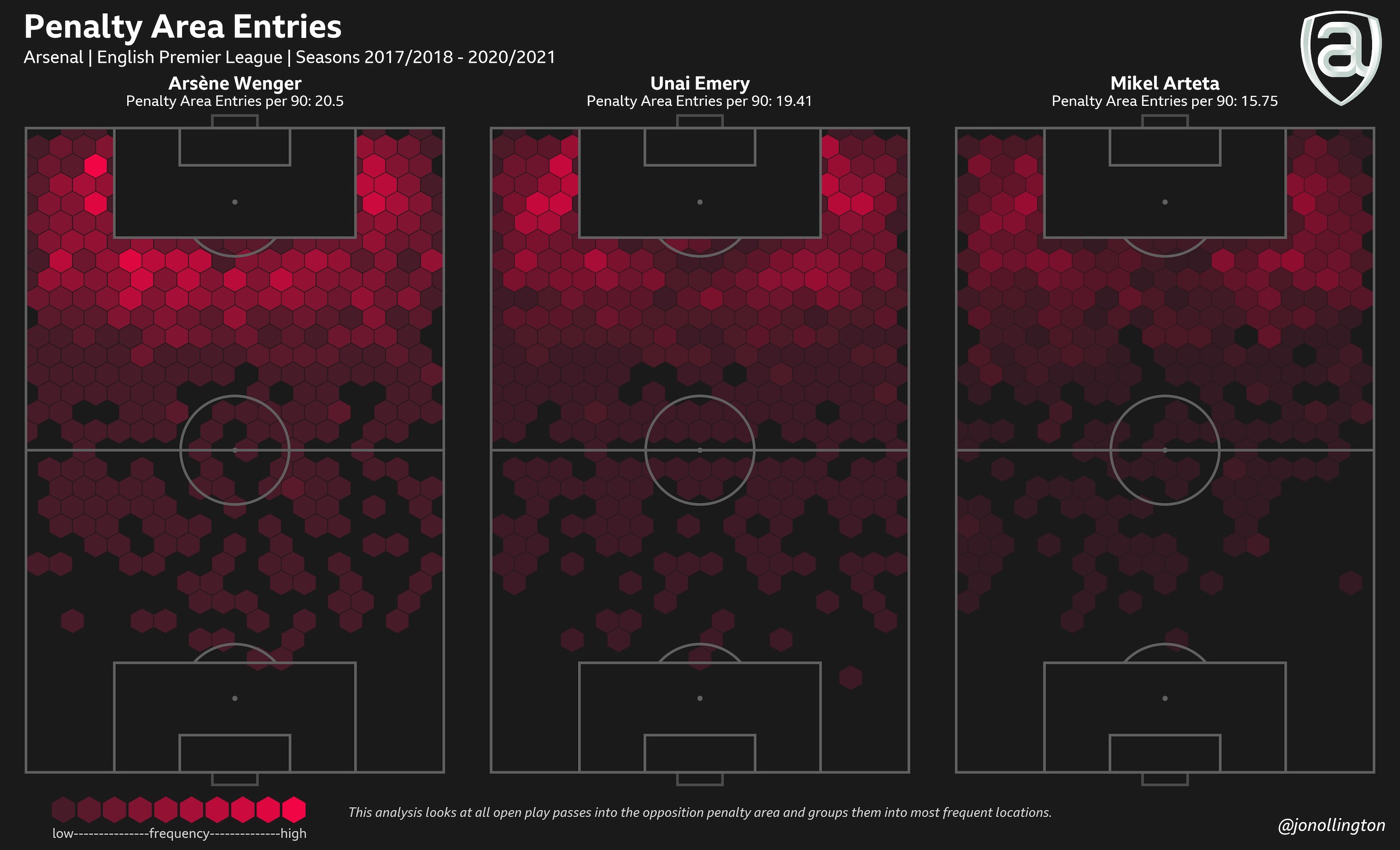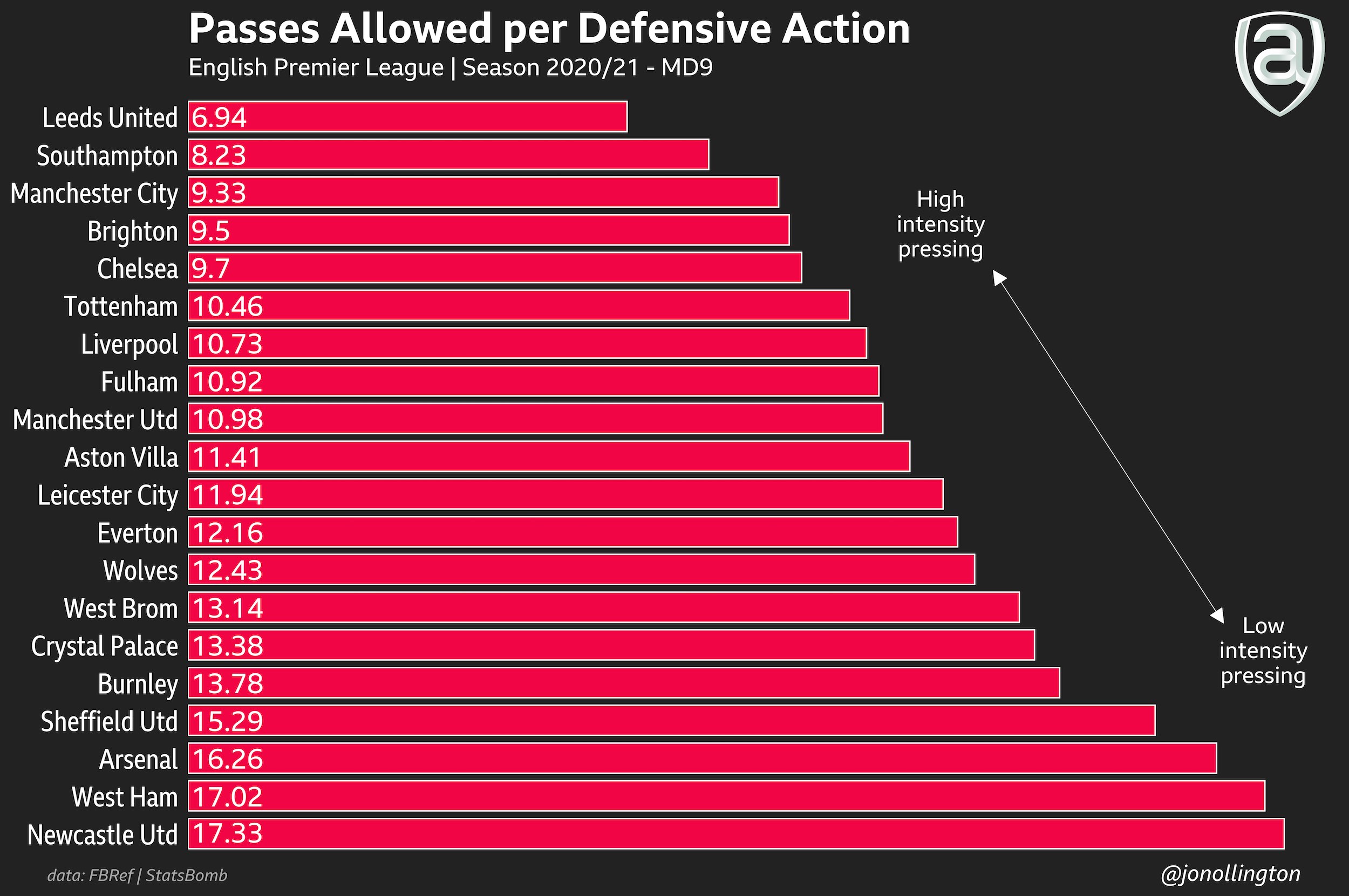The honeymoon period describes the heady stages of a new relationship, when everything is exciting and little goes wrong. This rings true for Arsenal and Mikel Arteta – within his first eight months at the helm, there were wins against the type of opposition with whom we associate defeat, and which culminated in FA Cup and Community Shield success. Fast forward just a few months and we’re starting to notice Mikel wearing his socks to bed and forgetting to take the recycling out on a Thursday night.
However, those who expected a blissful marriage after toasting early success haven’t been paying close enough attention, and so while it might seem that the elusive honeymoon period is over, it’s worth scratching beneath the surface. The former club-captain took over a mess and a squad ill-suited to the possession-based style he’s trying so hard to implement.
Before continuing, let’s clear up Expected Goals (xG). It’s a terrible name. Put simply, xG tells us the quantity and quality of chances that each team creates within a game of football. When looking back on results, opinions on which side played better are more often than not based on scoring chances. Expected Goals is simply a way of quantifying those scoring chances. So when you compare expected goal difference with actual goal difference, it paints a picture of times where teams score more, or fewer, goals than the underlying data suggests.
Below depicts Arsenal’s scoring opportunities for and against (xG difference) versus actual goal difference on a rolling 10 game average, from Wenger’s final season right up to present day.

What’s glaringly obvious is that both Emery and Arteta enjoyed spells collectively scoring above, while conceding below expectation based on chance quality. During Emery’s 14 game Premier League unbeaten streak, Arsenal scored 33 times, but from chance quality, according to xG, that should return just 21 goals.

To add further context, above are the shot locations during Wenger’s final season and Emery’s first. Arsene’s Arsenal took 131 more shots (!) but only amassed 6 more in their xG total – so an expected goal for every additional 22 shots taken. Or simply, Wenger’s team were taking a lot more shots from substandard locations and unsurprisingly failing to find the target frequently. Yet amazingly, it was Emery’s Arsenal who managed to score from these low quality chances, while attempting them a fraction of the time.
There was a similar story down the other end of the pitch, as poor finishing from the opposition and the performances of Leno turned defeats into draws and draws into wins. That’s football – teams win games they shouldn’t all the time. However, it was never a sustainable means to continued success. So when Unai Emery went from a 22-game unbeaten streak in all competitions to overseeing Arsenal’s worst run without a victory since 1992, it came as little surprise to anyone with the slightest interest in Football Analytics. The xG gods came home to roost and almost a year to the day, Emery said his final Good Ebening.
Unfortunately, Arteta’s time in charge is beginning to show some similarities with the previous Head Coach. Both managers enjoyed remarkable starts, but have shown the same disparity in underlying statistics as results have helped paper over the cracks of a poorly constructed squad.

As illustrated above, Arteta’s side are creating good goal scoring opportunities – around 1.1 expected goals per game, but from a measly 9 shots. For context, Liverpool attempt 17 per game, while the attacking forces of Newcastle and Palace register similar numbers to Arsenal. Chance creation starts to become inconsequential with so few shots over the course of 90 minutes and leaves little wriggle room for missing, causing extra pressure.
Last season this approach worked to a certain extent, as only Liverpool had a better chance conversion rate than Arsenal’s 14.4%, but that figure has already dropped this year to 11%, and reaffirms the current perfectionist approach is also not a sustainable route to continually winning football matches.
Creativity has been an issue for a while. Nicolas Pepe supplied just 6 league assists in his debut season – topping said column for the club, but only sufficient enough to hang with the likes of Cesar Azpilicueta in the assist charts. You could argue those numbers if everyone else was chipping in, but Arsenal ranked 15th in chances created (9 minutes per shot), and have seen that figure fall further to 10.4 minutes (ranked 16th) in 20/21.

So it’ll come as no surprise to learn that ball progression into the opposition box is also in decline. While it’s apparent the wings have long been the preferred route of attack, it’s worrying to see such a drop in threat being generated through the middle. Wenger had a plethora of playmakers who thrived on finding space in tight situations and who could open up the opposition in those congested central areas. Mikel Arteta does not have that luxury (in his current match-day squad). It’s no secret Houssem Aouar was the manager’s preferred transfer choice and had the pursuit of the playmaker been successful, he’d no doubt offer that extra dimension to an otherwise blunt attack, but the manager needs to find an effective way of working with the players at his disposal.
In the absence of conventional playmakers, implementing a press and forcing errors is an effective alternative in fashioning more goalscoring opportunities. It’s a tactic commonly associated with Pep Guardiola and was implemented by Arteta during his early days, but is almost nonexistent this season.
However, the trip to Old Trafford should serve as a reminder as both Thomas Partey and Mo Elneny produced a pressing masterclass and exemplified how effective closing down the opposition can be when done well.

If I’ve still got your attention after expected goals and penalty box entries, I fear PPDA (Passes per Defensive Actions) is a stretch too far. But it’s a solid indication of pressing intensity (not press quality) and measures how many passes you let your opponents complete before winning the ball back – as experly explained by Dom in a recent By the Visuals. The following graph further highlights just how little we’re attempting to press at present.

There are countless teams in the modern game who epitomise how trivial possession can be in creating quality chances and it seems as if our current style of possession without progression is antithetical to the current matchday squad. But in Gabriel and Partey, the manager now has two players in the starting eleven that were signed solely on his watch, plus captain he personally convinced to stay, and a number-one goalkeeper he rated highly enough to sell a popular number-two. That’s half a team.
Arteta was head coach when the club made the Pablo Mari and Cedric deals permanent, as well as extending Luiz for another season, and giving Willian a three year contract – although Raul Sanllehi’s influence as Head of Football can’t be overlooked in those deals. It was also his choice to freeze out Ozil, Sokratis, Guendouzi, give Mustafi a more prominent role, and decide that William Saliba wasn’t quite ready yet. The squad might not be suited to possession based football, but the manager has to be held accountable. This is Arteta’s team now.
However, and with all that said, just a year ago Arteta had never managed a football match and the levels of toxicity around Arsenal were at an all time high as every fan accepted that whoever inherited the car crash Emery would leave behind had some job on their hands. In the 11 months that followed, the rookie manager delivered silverware, instilled a defined system and went about solving a lot of the defensive issues that became Wenger’s achilles heel. There are very few teams that sustain any sort of success by changing their manager every other season and Arsenal’s problems lie quite a lot deeper than the current manager. As Andrew wrote in greater detail and more eloquently than I can, now is the time for stability.
So to finish on a note of optimism, last season 46% of all goals conceded came from set pieces. At the time of writing, Arsenal haven’t conceded a single goal from a dead-ball situation. The manager identified an area of weakness and corrected it. Last weekend our star striker played in a position closer to the opposition goal and perhaps hints at further problem-solving and better days to come.
Follow me on Twitter @jonollington





love the graphics. such high quality analysis.
Phew! We can all sleep a little more soundly now, can’t we. Can’t we?
We just don’t have players up top who can protect the ball hence can’t sustain pressure around opposition box. Arteta’s team selection as well as his formatiom doesn’t inspire much attacking intent too. So far, we have sacrificed a lot more in attack for a little bit defensive improvement. He’s also only invested in defensive players which is where he has focused most of his energy. I don’t believe, a man who worked with Pep and played under Wenger, does not have an attacking game, its just not possible. I just hope he turns it on sooner rather than later.… Read more »
This is a great article. The data visualizations are wonderful!
Amazing work with the analysis, it makes for interesting reading. Although, I am a little disappointed that with all that great analysis Jon believes that four players makes up half a team.
I lol’d. Numbers obviously not my strong point.
Patience — Arteta will get us there.
Excellent analysis and really fair points. Two thoughts – the “process”, as annoying as it is to refer to and think about, is necessary, the fact of it is, we are a club that has been in a rut for over a decade now and fixing that will take time. It’s especially frustrating considering to keep waiting but, and I think this is important, this idea that the process is a smooth and gradual uphill climb needs to be abolished. It’s going to be bumpy and there are going to be lows and woeful performances. It’s important we hold the… Read more »
considering how long we’ve waited already* wow missed a whole sentence there!
This is brilliant
Good read!
This is great, almost feel bad about calling the police about that slanted Y-Axis legend in the final image.
Great work Jon. Brilliant article.
Wow dude this article was outstanding! Excellent visuals and well-written too, tell Blogs we want more features please.
The penalty area entries and the pressing visuals hurt to look at. Thanks for the tidbit on set piece defense, I’d been wondering that the last few games. Would be interested in an analysis of our various attacking set pieces from free kicks to corners – the crowd the goalie thing we seem to be doing doesn’t appear too effective.
Fantastic piece, Jon!
Particularly liked the bit on our rolling G/xG difference. Would love to see the same visual for xGoals-Against to see if Arteta really has finally brought us some defensive stability